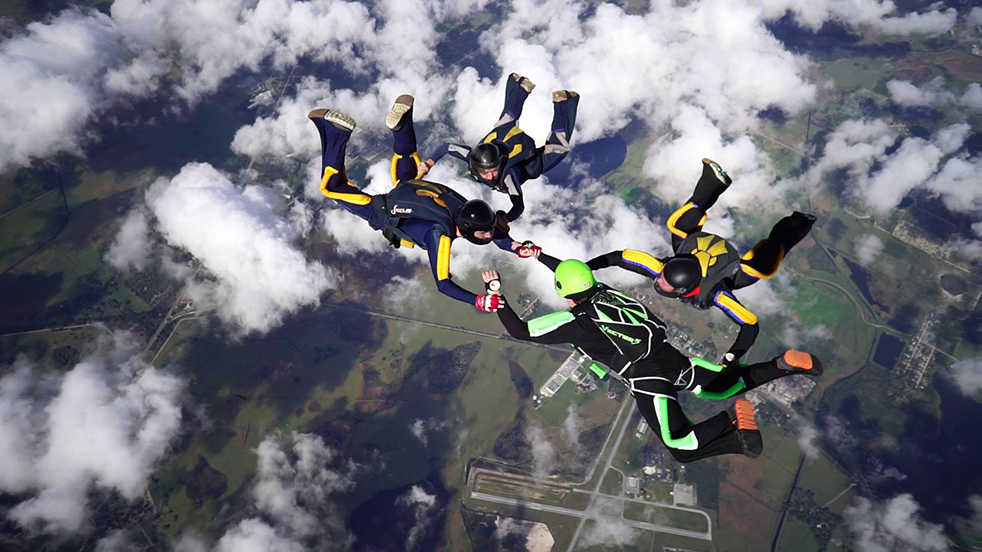In 1958, two Tech students jumped out of a plane and passed a baton during freefall. Steve Snyder and Charles Hillard, Jr. were the first people to perform such a feat in the United States. Soon a whole new discipline of skydiving developed: formation or relative flying, where jumpers form groups in the air, making a sequence of formations within a time limit.
About a decade later, Tech’s Sport Parachute Club was formed in 1969, one of the oldest collegiate skydiving clubs in the nation. Over the years, Collegiate National medals have been won; world records have been set and many alumni have stayed involved in the sport. The club offers both competitive events and opportunities for people to jump for fun.
The main competitive types are formation events: accuracy events, where jumpers try to land as close to the target as possible; speedstar, where people dive bomb out and make a formation as quickly as possible; and freeflying, where jumpers are in a vertical position instead of a horizontal position. A tandem jump, where one is attached to an instructor, is where the skydiving journey begins.
Those who want to pursue more get Advanced Free Fall (AFF) certification, which requires six hours of ground school and then progressive levels of jumps. According to former President Greyson Daugherty, “the solo jump after certification is freeing because those first jumps feel like you’re taking an exam in the sky.” Completing AFF allows students to officially join the club. While the cost of AFF is steep at approximately $1,500, subsequent jumps through the club are much cheaper than buying or renting gear by oneself. Getting people into the sport as economically as possible is a key club goal.
Despite a perception of skydiving as scary or dangerous, “skydiving is actually safer than driving a car. A large majority of deaths from the sport come for negligence, which is something our club watches for carefully,” said President Nikki Cantrell. One of her responsibilities is to ensure that everyone is abiding by the rules and establish new guidelines as necessary to promote safety to the maximum possible extent.
While current and former members had various reasons for beginning to skydive — a roommate constantly talking about it, needing something to look forward to after a divorce, or being encouraged by a friend to try out for a military academy team during undergrad — one reason kept jumpers coming back weekend after weekend.
Skydiving provides an escape from the stress of Tech, a refreshing change of pace from hours staring at screens and a way to clear one’s head. “It is kinda ironic that the best way to maintain your sanity was to do something kind of insane,” said Daugherty of the sport’s thrill.
According to Club Quartermaster Arthur Murphy, responsible for looking after gear, “people think it’s just skydiving, but it’s more of a lifestyle.” The broad sport contains many disciplines, but the camaraderie between jumpers from across the country is evident at the Collegiate Nationals, with “150 of your best friends that you see a couple times a year. Everyone’s happy for you, you’re happy for them,” said former President Greg Lenartz.
For those who are curious about the sport but nervous about trying it themselves, members suggest doing a tandem jump first or going to fly in a wind tunnel. In 2016, the iFLY wind tunnel opened in Smyrna, which allows quicker feedback and turnaround than actual jumps. “If you’re wondering if you want to be a skydiver, then you need to do it because if you don’t, you’ll always be kicking yourself. It’s an experience that is overwhelming, but it’s so liberating,” explained Murphy.
While many club members enjoy competing, the club also exists to show newcomers a fun time, involve them in the sport, and model what a good skydive and skydiver is. As a skydiving instructor, Murphy enjoys “sharing something that I really love with people that matter to me.”
60 years after Snyder and Hillard made that first precarious jump, skydiving remains a highly popular pastime at Tech. A diverse range of competitors, from undergraduates to Ph.D students, those with a military background and those just seeking an extra jolt of excitement, are all bound by their love of falling at high velocity.
